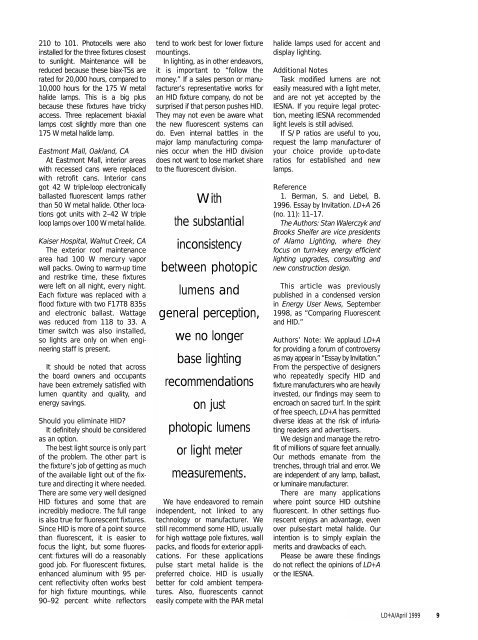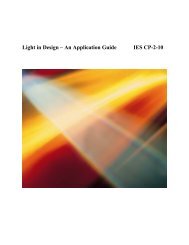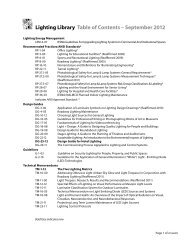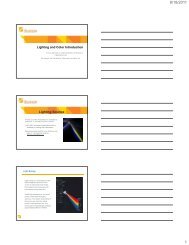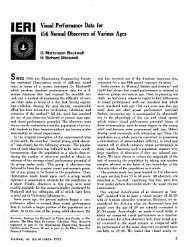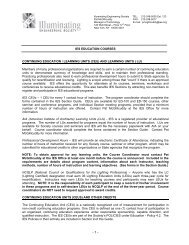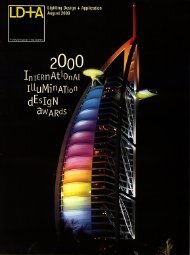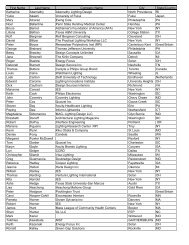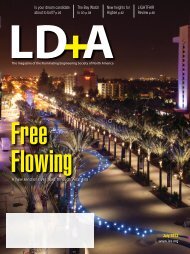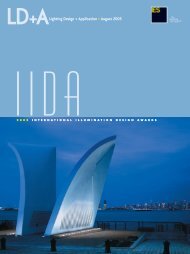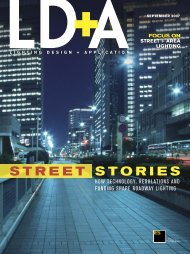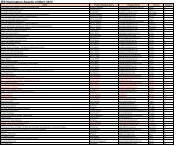lightfair international - Illuminating Engineering Society
lightfair international - Illuminating Engineering Society
lightfair international - Illuminating Engineering Society
You also want an ePaper? Increase the reach of your titles
YUMPU automatically turns print PDFs into web optimized ePapers that Google loves.
210 to 101. Photocells were also<br />
installed for the three fixtures closest<br />
to sunlight. Maintenance will be<br />
reduced because these biax-T5s are<br />
rated for 20,000 hours, compared to<br />
10,000 hours for the 175 W metal<br />
halide lamps. This is a big plus<br />
because these fixtures have tricky<br />
access. Three replacement bi-axial<br />
lamps cost slightly more than one<br />
175 W metal halide lamp.<br />
Eastmont Mall, Oakland, CA<br />
At Eastmont Mall, interior areas<br />
with recessed cans were replaced<br />
with retrofit cans. Interior cans<br />
got 42 W triple-loop electronically<br />
ballasted fluorescent lamps rather<br />
than 50 W metal halide. Other locations<br />
got units with 2–42 W triple<br />
loop lamps over 100 W metal halide.<br />
Kaiser Hospital, Walnut Creek, CA<br />
The exterior roof maintenance<br />
area had 100 W mercury vapor<br />
wall packs. Owing to warm-up time<br />
and restrike time, these fixtures<br />
were left on all night, every night.<br />
Each fixture was replaced with a<br />
flood fixture with two F17T8 835s<br />
and electronic ballast. Wattage<br />
was reduced from 118 to 33. A<br />
timer switch was also installed,<br />
so lights are only on when engineering<br />
staff is present.<br />
It should be noted that across<br />
the board owners and occupants<br />
have been extremely satisfied with<br />
lumen quantity and quality, and<br />
energy savings.<br />
Should you eliminate HID<br />
It definitely should be considered<br />
as an option.<br />
The best light source is only part<br />
of the problem. The other part is<br />
the fixture’s job of getting as much<br />
of the available light out of the fixture<br />
and directing it where needed.<br />
There are some very well designed<br />
HID fixtures and some that are<br />
incredibly mediocre. The full range<br />
is also true for fluorescent fixtures.<br />
Since HID is more of a point source<br />
than fluorescent, it is easier to<br />
focus the light, but some fluorescent<br />
fixtures will do a reasonably<br />
good job. For fluorescent fixtures,<br />
enhanced aluminum with 95 percent<br />
reflectivity often works best<br />
for high fixture mountings, while<br />
90–92 percent white reflectors<br />
tend to work best for lower fixture<br />
mountings.<br />
In lighting, as in other endeavors,<br />
it is important to “follow the<br />
money.” If a sales person or manufacturer’s<br />
representative works for<br />
an HID fixture company, do not be<br />
surprised if that person pushes HID.<br />
They may not even be aware what<br />
the new fluorescent systems can<br />
do. Even internal battles in the<br />
major lamp manufacturing companies<br />
occur when the HID division<br />
does not want to lose market share<br />
to the fluorescent division.<br />
With<br />
the substantial<br />
inconsistency<br />
between photopic<br />
lumens and<br />
general perception,<br />
we no longer<br />
base lighting<br />
recommendations<br />
on just<br />
photopic lumens<br />
or light meter<br />
measurements.<br />
We have endeavored to remain<br />
independent, not linked to any<br />
technology or manufacturer. We<br />
still recommend some HID, usually<br />
for high wattage pole fixtures, wall<br />
packs, and floods for exterior applications.<br />
For these applications<br />
pulse start metal halide is the<br />
preferred choice. HID is usually<br />
better for cold ambient temperatures.<br />
Also, fluorescents cannot<br />
easily compete with the PAR metal<br />
halide lamps used for accent and<br />
display lighting.<br />
Additional Notes<br />
Task modified lumens are not<br />
easily measured with a light meter,<br />
and are not yet accepted by the<br />
IESNA. If you require legal protection,<br />
meeting IESNA recommended<br />
light levels is still advised.<br />
If S/P ratios are useful to you,<br />
request the lamp manufacturer of<br />
your choice provide up-to-date<br />
ratios for established and new<br />
lamps.<br />
Reference<br />
1. Berman, S. and Liebel, B.<br />
1996. Essay by Invitation. LD+A 26<br />
(no. 11): 11–17.<br />
The Authors: Stan Walerczyk and<br />
Brooks Sheifer are vice presidents<br />
of Alamo Lighting, where they<br />
focus on turn-key energy efficient<br />
lighting upgrades, consulting and<br />
new construction design.<br />
This article was previously<br />
published in a condensed version<br />
in Energy User News, September<br />
1998, as “Comparing Fluorescent<br />
and HID.”<br />
Authors’ Note: We applaud LD+A<br />
for providing a forum of controversy<br />
as may appear in “Essay by Invitation.”<br />
From the perspective of designers<br />
who repeatedly specify HID and<br />
fixture manufacturers who are heavily<br />
invested, our findings may seem to<br />
encroach on sacred turf. In the spirit<br />
of free speech, LD+A has permitted<br />
diverse ideas at the risk of infuriating<br />
readers and advertisers.<br />
We design and manage the retrofit<br />
of millions of square feet annually.<br />
Our methods emanate from the<br />
trenches, through trial and error. We<br />
are independent of any lamp, ballast,<br />
or luminaire manufacturer.<br />
There are many applications<br />
where point source HID outshine<br />
fluorescent. In other settings fluorescent<br />
enjoys an advantage, even<br />
over pulse-start metal halide. Our<br />
intention is to simply explain the<br />
merits and drawbacks of each.<br />
Please be aware these findings<br />
do not reflect the opinions of LD+A<br />
or the IESNA.<br />
LD+A/April 1999 9


